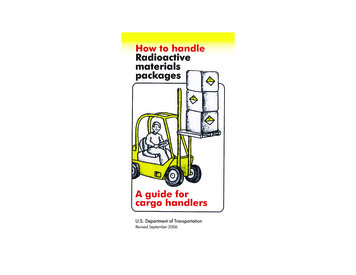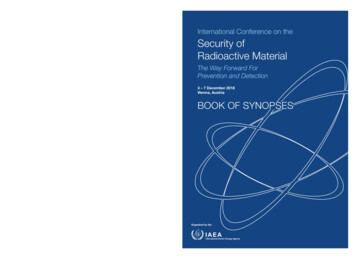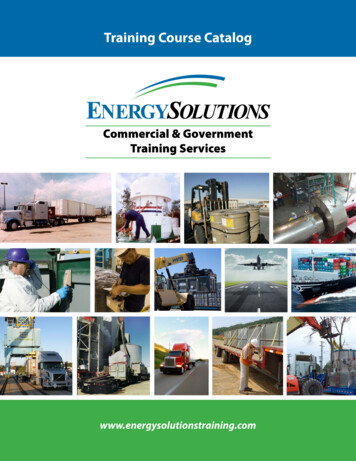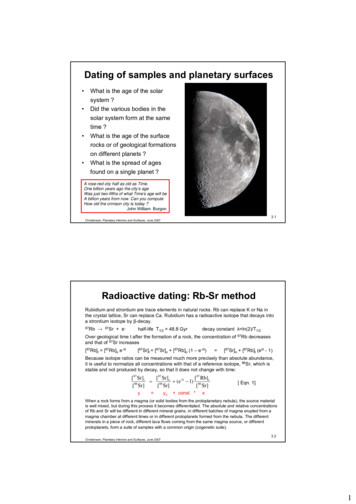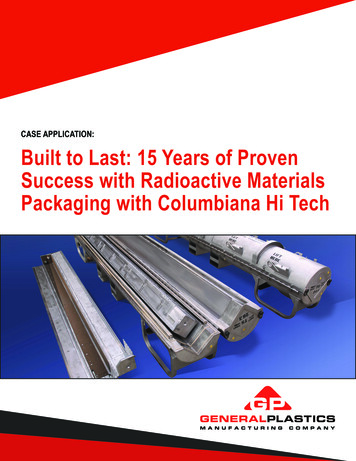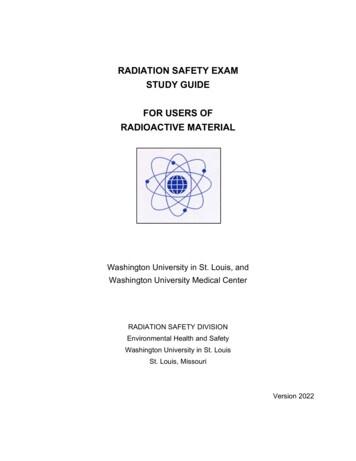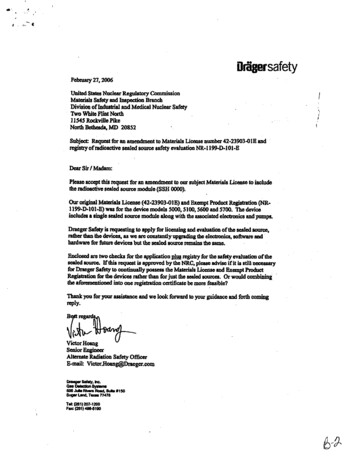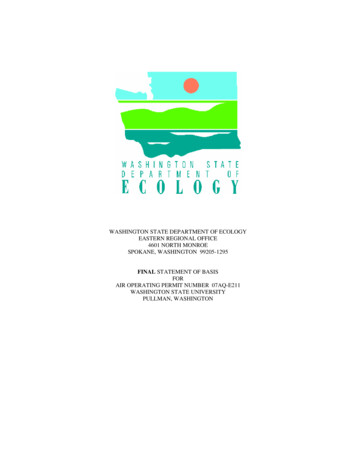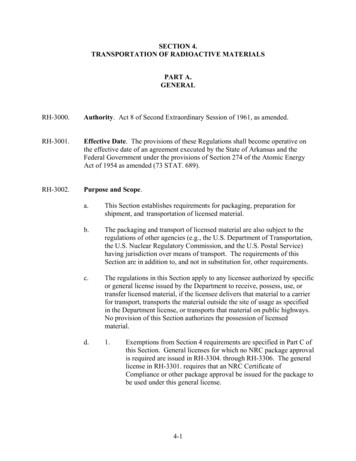
Transcription
SECTION 4.TRANSPORTATION OF RADIOACTIVE MATERIALSPART A.GENERALRH-3000.Authority. Act 8 of Second Extraordinary Session of 1961, as amended.RH-3001.Effective Date. The provisions of these Regulations shall become operative onthe effective date of an agreement executed by the State of Arkansas and theFederal Government under the provisions of Section 274 of the Atomic EnergyAct of 1954 as amended (73 STAT. 689).RH-3002.Purpose and Scope.a.This Section establishes requirements for packaging, preparation forshipment, and transportation of licensed material.b.The packaging and transport of licensed material are also subject to theregulations of other agencies (e.g., the U.S. Department of Transportation,the U.S. Nuclear Regulatory Commission, and the U.S. Postal Service)having jurisdiction over means of transport. The requirements of thisSection are in addition to, and not in substitution for, other requirements.c.The regulations in this Section apply to any licensee authorized by specificor general license issued by the Department to receive, possess, use, ortransfer licensed material, if the licensee delivers that material to a carrierfor transport, transports the material outside the site of usage as specifiedin the Department license, or transports that material on public highways.No provision of this Section authorizes the possession of licensedmaterial.d.1.Exemptions from Section 4 requirements are specified in Part C ofthis Section. General licenses for which no NRC package approvalis required are issued in RH-3304. through RH-3306. The generallicense in RH-3301. requires that an NRC Certificate ofCompliance or other package approval be issued for the package tobe used under this general license.4-1
RH-3002.d. (Cont’d)2.RH-3003.RH-3004.A licensee transporting licensed material, or delivering licensedmaterial to a carrier for transport, shall comply with theoperating control requirements of Part F; the quality assurancerequirements of Part G; and the general provisions of Part A,including referenced U.S. Department of Transportationregulations.Communications and Records.a.Except where otherwise specified, all communications concerning theseRegulations may be addressed to the Arkansas Department of Health,Radiation Control Section, 4815 West Markham Street, Slot 30, LittleRock, Arkansas, 72205-3867.b.Each record required by this section must be legible throughout theretention period specified by each Department regulation. The recordmay be the original, a reproduced copy, or a microform provided thatthe copy or microform is authenticated by authorized personnel andthat the microform is capable of producing a clear copy throughout therequired retention period. The record may also be stored in electronicmedia with the capability for producing legible, accurate, and completerecords during the required retention period. Records such as letters,drawings, and specifications must include all pertinent information such asstamps, initials, and signatures. The licensee shall maintain adequatesafeguards against tampering with and loss of records.Requirement for License.Except as authorized in a general license or a specific license issued by theDepartment, or as exempted in this Section, no licensee may:a.Deliver licensed material to a carrier for transport; orb.Transport licensed material.4-2
RH-3005.Transportation of Radioactive Material.a.Each licensee who transports licensed material outside the site of usage, asspecified in the Department license, or where transport is on publichighways, or who delivers licensed material to a carrier for transport, shallcomply with the applicable requirements of the DOT regulations in49 CFR parts 107, 171 through 180, and 390 through 397, appropriate tothe mode of transport.1.2.The licensee shall particularly note DOT regulations in thefollowing areas:A.Packaging--49 CFR part 173: Subparts A, B, and I.B.Marking and labeling--49 CFR part 172: Subpart D;and §§ 172.400 through 172.407 and §§ 172.436 through172.441 of Subpart E.C.Placarding--49 CFR part 172: Subpart F, especially§§ 172.500 through 172.519 and 172.556; and appendicesB and C.D.Accident reporting--49 CFR part 171: §§ 171.15 and171.16.E.Shipping papers and emergency information--49 CFRpart 172: Subparts C and G.F.Hazardous material employee training--49 CFR part 172:Subpart H.G.Security plans--49 CFR part 172: Subpart I.H.Hazardous material shipper/carrier registration--49 CFRpart 107: Subpart G.The licensee shall also note DOT regulations pertaining to thefollowing modes of transportation:A.Rail--49 CFR part 174: Subparts A through D and K.B.Air--49 CFR part 175.C.Vessel--49 CFR part 176: Subparts A through F and M.4-3
RH-3005.a.2. (Cont’d)D.b.RH-3006.Public Highway--49 CFR part 177 and parts 390 through397.If DOT regulations are not applicable to a shipment of licensed material,the licensee shall conform to the standards and requirements of the DOTspecified in RH-3005.a. of this section to the same extent as if theshipment or transportation were subject to DOT regulations. A request formodification, waiver, or exemption from those requirements, and anynotification referred to in those requirements, must be filed with, or madeto, the Arkansas Department of Health, Radiation Control Section, 4815West Markham Street, Slot 30, Little Rock, Arkansas, 72205-3867.Interpretations.Except as specifically authorized by the Department in writing, no interpretationsof the meaning of the regulations in this Section by an officer or employee of theDepartment other than a written interpretation by the Department Director ordesignee will be recognized as binding upon the Department.RH-3007.- RH-3099. Reserved.4-4
PART B.DEFINITIONSRH-3100.Definitions.The following terms are as defined for the purpose of this Section. To ensurecompatibility with international transportation standards, all limits in this Sectionare given in terms of dual units: The International System of Units (SI) followedor preceded by U.S. standard or customary units. The U.S. customary units arenot exact equivalents, but rounded to a convenient value, providing a functionallyequivalent unit. For the purpose of this Section, either unit may be used.A1 - Maximum activity of special form of radioactive material permitted in a TypeA package. These values are either listed in Table A-1 of Appendix A to thisSection or may be derived in accordance with the procedure prescribed inAppendix A.A2 - Maximum activity of radioactive material, other than special form, LSA andSCO material, permitted in a Type A package. These values are either listed inTable A-1 of Appendix A to this Section or may be derived in accordance withthe procedure prescribed in Appendix A.Act - Act 8 of Second Extraordinary Session of 1961, as amended.Carrier - A person engaged in the transportation of passengers or property byland or water as a common, contract, or private carrier, or by civil aircraft.Certificate Holder – a person who has been issued a Certificate of Complianceor other package approval by the U.S. Nuclear Regulatory Commission.Certificate of Compliance (CoC) - the certificate issued by the U.S. NuclearRegulatory Commission which approves the design of a package for thetransportation of radioactive material.CFR - Code of Federal Regulations.Close reflection by water - immediate contact by water of sufficient thicknessfor maximum reflection of neutrons.Consignment - Each shipment of a package or groups of packages or load ofradioactive material offered by a shipper for transport.Containment system - the assembly of components of the packaging intended toretain the radioactive material during transport.4-5
RH-3100. (Cont’d)Contamination - The presence of a radioactive substance on a surface inquantities in excess of 0.4 Bq/cm2 (1 x 10-5 μCi/cm2) for beta and gamma emittersand low toxicity alpha emitters, or 0.04 Bq/cm2 (1 x 10-6 μCi/cm2) for all otheralpha emitters.1.Fixed contamination - Contamination that cannot be removed from asurface during normal conditions of transport.2.Non-fixed contamination - Contamination that can be removed from asurface during normal conditions of transport.Conveyance 1.For transport by public highway or rail, any transport vehicle or largefreight container;2.For transport by water, any vessel, or any hold, compartment, or defineddeck area of a vessel including any transport vehicle on board the vessel;and3.For transport by any aircraft.Criticality Safety Index (CSI) - The dimensionless number (rounded up to thenext tenth) assigned to and placed on the label of a fissile material package, todesignate the degree of control of accumulation of packages, overpacks, or freightcontainers containing fissile material during transportation. Determination of thecriticality safety index is described in RH-3305., RH-3306., and in 10 CFR 71.59.The criticality safety index for an overpack, freight container, consignment, orconveyance containing fissile material packages is the arithmetic sum of thecriticality safety indices of all the fissile material packages contained within theoverpack, freight container, consignment, or conveyance.Deuterium - For the purposes of RH-3203. and RH-3305., deuterium and anydeuterium compounds, including heavy water, in which the ratio of deuteriumatoms to hydrogen atoms exceeds 1:5000.DOT - The U.S. Department of Transportation.4-6
RH-3100. (Cont’d)Exclusive use (also referred to in other regulations as “sole”) - The sole use of aconveyance by a single consignor of a conveyance for which all initial,intermediate, and final loading and unloading are carried out in accordance withthe direction of the consignor or consignee. The consignor and the carrier mustensure that any loading or unloading is performed by personnel havingradiological training and resources appropriate for safe handling of theconsignment. The consignor must issue specific instructions, in writing, formaintenance of exclusive use shipment controls, and include them with theshipping paper information provided by the consignor.Fissile material - The radionuclides uranium-233, uranium-235,plutonium-239, and plutonium-241, or any combination of these radionuclides.Fissile material means the fissile nuclides themselves, not material containingfissile nuclides. Unirradiated natural uranium and depleted uranium, that hasbeen irradiated in thermal reactors only, are not included in this definition.Certain exclusions from fissile material controls are provided in RH-3203.Graphite - For the purposes of RH-3203 and RH-3305, graphite with a boronequivalent content less than five (5) parts per million and density greater than 1.5grams per cubic centimeter.Indian Tribe - An Indian or Alaska native Tribe, band, nation, pueblo, village, orcommunity that the Secretary of the Interior acknowledges to exist as an IndianTribe pursuant to the Federally Recognized Indian Tribe List Act of 1994, 25U.S.C. 479a.Licensed material - Radioactive material received, possessed, used, ortransferred under a general or specific license issued by the Department pursuantto the regulations in this Section.Low Specific Activity (LSA) - Radioactive material with limited specific activitywhich is nonfissile or is excepted under RH-3203. and which satisfies thedescriptions and limits set forth below. Shielding materials surrounding the LSAmaterial may not be considered in determining the estimated average specificactivity of the package contents. The LSA material must be in one of threegroups:1.LSA-I:A.Uranium and thorium ores, concentrates of uranium and thoriumores, and other ores containing naturally occurring radioactiveradionuclides that are intended to be processed for the use of theseradionuclides;4-7
RH-3100. (Cont’d)2.3.B.Natural uranium, depleted uranium, natural thorium, or theircompounds or mixtures, provided they are unirradiated and in solidor liquid form;C.Radioactive material other than fissile material, for which the A2value is unlimited; orD.Other radioactive material in which the activity is distributedthroughout and the estimated average specific activity does notexceed 30 times the value for exempt material activityconcentration determined in accordance with Appendix A toSection 4.LSA-II:A.Water with tritium concentration up to 0.8 TBq/liter (20.0 Ci/liter);orB.Other radioactive material in which the activity is distributedthroughout and the estimated average specific activity does notexceed 10-4 A2/g for solid and gases, and 10-5 A2/g for liquids.LSA-III:Solids (e.g., consolidated wastes, activated materials), excluding powders,that satisfy the requirements of 10 CFR 71.77, in which:A.The radioactive material is distributed throughout a solid or acollection of solid objects, or is essentially uniformly distributed ina solid compact binding agent (such as concrete, bitumen, ceramic,etc.);B.The radioactive material is relatively insoluble, or it is intrinsicallycontained in a relatively insoluble material, so that even under lossof packaging, the loss of radioactive material per package byleaching when placed in water for seven (7) days will not exceed0.1 A2.; andC.The estimated average specific activity of the solid, excluding anyshielding material, does not exceed 2 x 10-3A2/g.4-8
RH-3100. (Cont’d)Low toxicity alpha emitters - natural uranium, depleted uranium, naturalthorium; uranium-235, uranium-238, thorium-232, thorium-228, or thorium-230when contained in ores or physical or chemical concentrates or tailings; or alphaemitters with a half-life of less than ten (10) days.Maximum normal operating pressure - the maximum gauge pressure thatwould develop in the containment system in a period of one (1) year under theheat condition specified in 10 CFR 71.71(c)(1) in the absence of venting, externalcooling by an ancillary system, or operational controls during transport.Natural thorium - Thorium with the naturally occurring distribution of thoriumisotopes (essentially 100 weight percent thorium-232).Normal form radioactive material - Radioactive material that has not beendemonstrated to qualify as “special form radioactive material.”Optimum interspersed hydrogenous moderation - The presence ofhydrogenous material between packages to such an extent that the maximumnuclear reactivity results.Package - Packaging together with its radioactive contents as presented fortransport.1.Fissile material package or Type AF package, Type BF package, TypeB(U)F package, or Type B(M)F package - A fissile material packagingtogether with its fissile material contents.2.Type A package - A Type A packaging together with its radioactivecontents. A Type A package is defined and must comply with the DOTregulations in 49 CFR Part 173.3.Type B package - A Type B packaging together with its radioactivecontents. On approval, a Type B package design is designated by NRC asB(U) unless the package has a maximum normal operating pressure ofmore than 700 kilopascal (100 lb/in²) gauge or a pressure relief devicewhich would allow the release of radioactive material to the environmentunder the tests specified in 10 CFR 71.73 (hypothetical accidentconditions), in which case it will receive a designation B(M). B(U) refersto the need for unilateral approval of international shipments; B(M) refersto the need for multilateral approval of international shipments.There is no distinction made in how packages with these designations maybe used in domestic transportation. To determine their distinction forinternational transportation, see DOT regulations in 49 CFR Part 173. A4-9
RH-3100. (Cont’d)Type B package approved prior to September 6, 1983, was designatedonly as Type B. Limitations on its use are specified in 10 CFR 71.19.Packaging - Assembly of components necessary to ensure compliance with thepackaging requirements of this Section. It may consist of one or morereceptacles, absorbent materials, spacing structures, thermal insulation, radiationshielding, and devices for cooling or absorbing mechanical shocks. The vehicle,tie-down system, and auxiliary equipment may be designated as part of thepackaging.Special form radioactive material - Radioactive material that satisfies thefollowing conditions:1.It is either a single solid piece or is contained in a sealed capsule that canbe opened only by destroying the capsule;2.The piece or capsule has at least one dimension not less than five (5)millimeters (0.2 inch); and3.It satisfies the requirements of 10 CFR 71.75. A special formencapsulation designed in accordance with the requirements of 10 CFR71.4 in effect on June 30, 1983 (see 10 CFR Part 71, revised as of January1, 1983), and constructed before July 1, 1985; a special formencapsulation designed in accordance with the requirements of 10 CFR71.4 in effect on March 31, 1996 (see 10 CFR Part 71, revised as ofJanuary 1, 1996), and constructed before April 1, 1998; and special formmaterial that was successfully tested before September 10, 2015, inaccordance with the requirements of 10 CFR 71.75(d) in effect beforeSeptember 10, 2015, may continue to be used. Any other special formencapsulation must meet the specifications of this definition.Specific activity of a radionuclide - The radioactivity of the radionuclide perunit mass of that nuclide. The specific activity of a material in which theradionuclide is essentially uniformly distributed is the radioactivity per unit massof the material.Spent nuclear fuel or Spent fuel -- Fuel that has been withdrawn from a nuclearreactor following irradiation, has undergone at least one (1) year's decay sincebeing used as a source of energy in a power reactor, and has not been chemicallyseparated into its constituent elements by reprocessing. Spent fuel includes thespecial nuclear material, byproduct material, source material, and otherradioactive materials associated with fuel assemblies.4-10
RH-3100. (Cont’d)State - A State of the United States, the District of Columbia, the Commonwealthof Puerto Rico, the Virgin Islands, Guam, American Samoa, and theCommonwealth of the Northern Mariana Islands.Surface Contaminated Object (SCO) - A solid object that is not itself classed asradioactive material, but which has radioactive material distributed on any of itssurfaces. SCO must be in one of two (2) groups with surface activity notexceeding the following limits:1.2.SCO-I: A solid object on which:A.The non-fixed contamination on the accessible surface averagedover 300 cm² (or the area of the surface if less than 300 cm²) doesnot exceed 10-4 microcurie/cm² (4 Bq/cm²) for beta and gammaand low toxicity alpha emitters, or 10-5 microcurie/cm² (0.4Bq/cm2) for all other alpha emitters; andB.The fixed contamination on the accessible surface averaged over300 cm² (or the area of the surface if less than 300 cm²) does notexceed 1.0 microcurie/cm² (4 x 104 Bq/cm2) for beta and gammaand low toxicity alpha emitters, or 0.1 microcurie/cm² (4 x 103Bq/cm) all other alpha emitters; andC.The non-fixed contamination plus the fixed contamination on theinaccessible surface averaged over 300 cm² (or the area of thesurface if less than 300 cm²) does not exceed 1.0 microcurie/cm² (4x 104 Bq/cm²) for beta and gamma and low toxicity alpha emitters,or 0.1 microcurie/cm² (4 x 103 Bq/cm²) all other alpha emitters.SCO-II: A solid object on which the limits for SCO-1 are exceeded andon which:A.The non-fixed contamination on the accessible surface averagedover 300 cm² (or the area of the surface if less than 300 cm2) doesnot exceed 10-2 microcurie/cm² (400 Bq/cm²) for beta and gammaand low toxicity alpha emitters, or 10-3 microcurie/cm² (40Bq/cm²) for all other alpha emitters;B.The fixed contamination on the accessible surface averaged over300 cm² (or the area of the surface if less than 300 cm²) does notexceed 20 microcurie/cm² (8 x 105 Bq/cm²) for beta and gammaand low toxicity alpha emitters, or 2 microcurie/cm² (8 x 104Bq/cm²) for all other alpha emitters; and4-11
RH-3100. (Cont’d)C.The non-fixed contamination plus the fixed contamination on theinaccessible surface averaged over 300 cm² (or the area of thesurface if less than 300 cm²) does not exceed 20 microcurie/cm² (8x 105 Bq/cm²) for beta and gamma and low toxicity alpha emitters,or 2 microcurie/cm² (8 x 104 Bq/cm²) for all other alpha emitters.Transport index - The dimensionless number (rounded up to the next tenth)placed on the label of a package, to designate the degree of control to be exercisedby the carrier during transportation. (The transport index is the numberdetermined by multiplying the maximum radiation level in millisievert (mSv) perhour at one (1) meter (3.3 ft) from the external surface of the package by 100(equivalent to the maximum radiation level in millirem per hour at one (1) meter(3.3 ft)).Tribal official - The highest ranking individual that represents Tribal leadership,such as the Chief, President, or Tribal Council leadership.Type A quantity - A quantity of radioactive material, the aggregate radioactivityof which does not exceed A1 for special form radioactive material or A2 fornormal form radioactive material, where A1 and A2 are given in Table A-1 ofAppendix A to this Section or may be determined by procedures described inAppendix A to this Section.Type B quantity - A quantity of radioactive material greater than a Type Aquantity.Unirradiated uranium - Uranium containing not more than 2 x 103 Bq ofplutonium per gram of uranium-235, not more than 9 x 106 Bq of fission productsper gram of uranium-235, and not more than 5 x 10-3 g of uranium-236 per gramof uranium-235.Uranium - natural, depleted, enriched.1.Natural uranium - Uranium (which may be chemically separated) withthe naturally occurring distribution of uranium isotopes (approximately0.711 weight percent uranium-235 and the remainder by weight essentiallyuranium-238).2.Depleted uranium - Uranium containing less uranium-235 than thenaturally occurring distribution of uranium isotopes.3.Enriched uranium - Uranium containing more uranium-235 than thenaturally occurring distribution of uranium isotopes.4-12
RH-3101.- RH-3199. Reserved.4-13
PART C.EXEMPTIONSRH-3200.Specific Exemptions.The Department may, upon application of any interested person or upon its owninitiative, grant such exemptions from the requirements of the regulations in thisSection as it determines are authorized by law and will not result in undue hazardto public health and safety or property, and are otherwise in the public interest.RH-3201.Exemption of Physicians.Any physician, as defined in RH-200., licensed by the State of Arkansas todispense drugs in the practice of medicine is exempt from RH-3005 with respectto transport by the physician of licensed material for use in the practice ofmedicine. However, any physician operating under this exemption must belicensed by the Department under Section 9 of these Regulations, U.S. NuclearRegulatory Commission’s 10 CFR Part 35 regulations or the equivalentAgreement State regulations.RH-3202.Exemption for Low-Level Radioactive Materials.A licensee is exempt from all the requirements of this Section with respect toshipment or carriage of the following low-level materials:a.Natural material and ores containing naturally occurring radionuclides thatare either in their natural state, or have only been processed for purposesother than for the extraction of the radionuclides, and which are notintended to be processed for use of these radionuclides, provided theactivity concentration of the material does not exceed ten (10) times theapplicable radionuclide activity concentration values specified in Table A2 or Table A-3 of Appendix A to Section 4.b.Materials for which the activity concentration is not greater than theactivity concentration values specified in Table A-2 or Table A-3 ofAppendix A to Section 4, or for which the consignment activity is notgreater than the limit for an exempt consignment found in Table A-2 orTable A-3 of Appendix A to Section 4.c.Non-radioactive solid objects with radioactive substances present on anysurfaces in quantities not in excess of the levels cited in the definition ofcontamination in RH-3100.4-14
RH-3203.Exemption from Classification as Fissile Material.Fissile material meeting the requirements of at least one of the paragraphsa. through f. of this section are exempt from classification as fissile material andfrom the fissile material package standards of 10 CFR 71.55 and 71.59, but aresubject to all other requirements of this Section, except as noted.a.Individual package containing two (2) grams or less fissile material.b.Individual or bulk packaging containing 15 grams or less of fissilematerial provided the package has at least 200 grams of solid nonfissilematerial for every gram of fissile material. Lead, beryllium, graphite,and hydrogenous material enriched in deuterium may be present in thepackage but must not be included in determining the required mass forsolid nonfissile material.c.1.2.Low concentrations of solid fissile material commingledwith solid nonfissile material, provided that:A.There is at least 2000 grams of solid nonfissile materialfor every gram of fissile material, andB.There is no more than 180 grams of fissile materialdistributed within 360 kg of contiguous nonfissile material.Lead, beryllium, graphite, and hydrogenous material enriched indeuterium may be present in the package but must not be includedin determining the required mass of solid nonfissile material.d.Uranium enriched in uranium-235 to a maximum of one percent (1%) byweight, and with total plutonium and uranium-233 content of up to onepercent (1%) of the mass of uranium-235, provided that the mass of anyberyllium, graphite, and hydrogenous material enriched in deuteriumconstitutes less than five percent (5%) of the uranium mass, and that thefissile material is distributed homogenously and does not form a latticearrangement within the package.e.Liquid solutions of uranyl nitrate enriched in uranium-235 to a maximumof two percent (2%) by mass, with a total plutonium and uranium-233content not exceeding 0.002 percent of the mass of uranium, and with aminimum nitrogen to uranium atomic ratio (N/U) of two (2). The materialmust be contained in at least a DOT Type A package.4-15
RH-3203. (Cont’d)f.Packages containing, individually, a total plutonium mass of not more than1000 grams, of which not more than twenty percent (20%) by mass mayconsist of plutonium-239, plutonium-241, or any combination of theseradionuclides.RH-3204.- RH-3299. Reserved.4-16
PART D.GENERAL LICENSESRH-3300.Reserved.RH-3301.General License for NRC-Approved Packages.a.A general license is hereby issued to any licensee of the Department totransport, or to deliver to a carrier for transport, licensed material in apackage for which a license, Certificate of Compliance (CoC), or otherapproval has been issued by the U.S. Nuclear Regulatory Commission.b.This general license applies only to a licensee who has a quality assuranceprogram approved by the Department as satisfying the provisions of PartG of this Section.c.Each licensee issued a general license under paragraph a. of this sectionshall:1.Maintain a copy of the CoC, or other approval of the package, andthe drawings and other documents referenced in the approvalrelating to the use and maintenance of the packaging and to theactions to be taken before shipment;2.Comply with the terms and conditions of the license, certificate, orother approval, as applicable, and the applicable requirements ofParts A, F, and G of this Section;3.Submit in writing before the first use of the package to the U.S.Nuclear Regulatory Commission: ATTN: Document ControlDesk, Director, Division of Spent Fuel Management, Office ofNuclear Material Safety and Safeguards, using an appropriatemethod listed in 10 CFR 71.1(a), the licensee's name and licensenumber and the package identification number specified in thepackage approval.d.This general license applies only when the package approval authorizesuse of the package under this general license.e.For a Type B or fissile material package, the design of which wasapproved by the U.S. Nuclear Regulatory Commission before April 1,1996, the general license is subject to the additional restrictions of10 CFR 71.19.4-17
RH-3302.Reserved.RH-3303.Reserved.RH-3304.General License for Use of Foreign Approved Package.a.A general license is hereby issued to any licensee of the Department totransport, or to deliver to a carrier for transport, licensed material in apackage, the design of which has been approved in a foreign nationalcompetent authority certificate, that has been revalidated by the U.S.Department of Transportation as meeting the applicable requirements of49 CFR 171.23.b.Except as otherwise provided in this section, the general license appliesonly to a licensee who has a quality assurance program approved by theDepartment as satisfying the applicable provisions of Part G of thisSection.c.This general license applies only to shipments made to or from locationsoutside the United States.d.Each licensee issued a general license under paragraph a. of this sectionshall:1.Maintain a copy of the applicable certificate, the revalidation, andthe drawings and other documents referenced in the certificate,relating to the use and maintenance of the packaging and to theactions to be taken before shipment; and2.Comply with the terms and conditions of the certificate andrevalidation, and with the applicable requirements of Parts A, F,and G of this Section.4-18
RH-3305.General License: Fissile Material.a.A general license is issued to any licensee of the Department to transportfissile material, or to deliver fissile material to a carrier for transport, if thematerial is shipped in accordance with this section. The fissile materialneed not be contained in a package which meets the standards of Part E ofthis Section and 10 CFR Part 71, Subparts E and F; however, the materialmust be con
C. Placarding--49 CFR part 172: Subpart F, especially §§ 172.500 through 172.519 and 172.556; and appendices . B and C. D. Accident reporting--49 CFR part 171: §§ 171.15 and . radiological training and resources appropriate for safe handling of the consignment. The consignor must issue specific instructions, in writing, for
